The Complete Guide to Growing Potatoes
This post may contain affiliate links, view our disclosure policy for details.
This complete guide to growing potatoes will teach you everything that you need to know about growing potatoes in the home garden. Learn how to grow potatoes for maximum production so you can enjoy your harvest for months!
The potato is the world’s fourth largest food crop. It is a starchy, tuberous crop with an ideal carbohydrate to protein ratio. 73% of its protein is easily utilized by humans, in fact, only eggs rank higher at 96%. In addition, potatoes also provide a significant amount of minerals and vitamins.
There are many ways of growing potatoes in the home garden. Over the past few years, I’ve tried a few.
The Complete Guide to Growing Potatoes….
Although I won’t necessarily classify potatoes as part of the group of easiest crops to grow (at least not here in the South mainly because of the Colorado potato beetle which we will talk more about later), they are not too hard either. And they are very well worth the effort not only because they are tasty, healthy and filling, but also because, if stored correctly, they can last a long time.
They are the perfect crop for the root cellar. If you manage to grow enough potatoes in early spring and store them the right way, you can enjoy homegrown (hopefully organic) potatoes for months after harvest!
Where to Get Seed Potatoes…
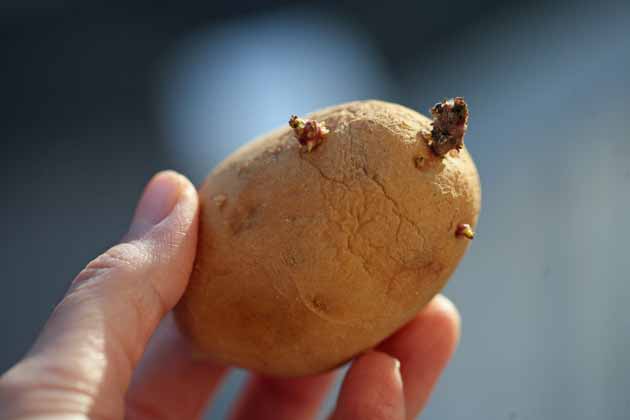
The first thing that you’ll need in order to grow potatoes are seed potatoes. Seed potatoes are not really seeds but actual potato tubers that were grown the year before. Since any disease that the plant has transfers to its tubers, potato plants that are grown for the production of seed potatoes are inspected regularly. The seed potatoes are also stored in the best conditions to make sure that they keep their firmness and freshness.
Seed potato growers usually certify their seed potatoes according to their state guidelines. The certification is a way to make sure that the varieties are true and that the seeds are free of disease and pests. You’ll get the best results if you start with certified seed potatoes.
You can save your own potatoes to plant in the following year, but consider that most of us don’t have the optimal conditions to store our potatoes for a full year. Many gardeners will report that their crop is not as good if they start with potatoes that they saved from the year before instead of seed potatoes.
Another common question is if it’s possible to grow potatoes from store-bought potatoes. One thing to take into consideration is that many of the potatoes sold in the store are sprayed with chemicals that prevent the potatoes from sprouting therefore, many of them won’t do great in the garden.
If you come by organic potatoes, you can plant them and they’ll probably sprout and grow nicely but again, you won’t get the same yield as you will if you start with certified seed potatoes.
Shop online – you’ll find many companies that sell seed potatoes online. Try Johnny’s Selected Seeds, The Maine Potato Lady, Southern Exposure Seed Exchange, Fedco Seeds, and there are many more.
Shop local – most garden centers and farm supply stores sell seed potatoes in early spring. I used to order my potatoes online until I found that our local Southern States and another local garden center have plenty of seed potatoes in the spring. Not only that I save the cost of shipping I can also choose my own potatoes. I can make sure that they aren’t damaged, already starting to sprout, and that they are my preferred size.
They usually have a few varieties so I can mix and try new varieties by picking just a couple of seed potatoes if I want (something that isn’t possible online). The local farm supply stores also usually sell only what is known to grow well in their area which saves me some of the research time.
Of course, the downside is that they don’t carry as many varieties as the online store so if you are looking for a variety that is not so common you might not find it at a local store.
Even if you choose to buy your seed potatoes locally, I recommend that you scroll through the varieties in the online shops that I mentioned above and read about them (more about potato varieties below) so you are familiar with the main varieties when you get to the store.
How Many Seed Potatoes Should You Get…
One pound of seed potatoes will plant between 6-10 feet row of potato plants (you’ll probably need to divide your potatoes. More on this below). One pound of fingerling potatoes will plant about 12 feet row. One pound of seed potatoes will produce about 10 pounds of potatoes.
So let’s say for example that you’d like to grow 100 pounds of potatoes for your family. You’ll need 10 pounds of seed potatoes and approximately 100 feet row. Sometimes it’s easier to figure out how many pounds of potatoes your family uses in a year and figure out how many seed potatoes and room you need from there. Year after year, as you grow potatoes you’ll have a better idea of what to expect. Just don’t forget that before you purchase and plant you have to make sure that you have a good place to store your harvest.
Varieties of Potatoes For the Home Garden…
There are so many different varieties of potatoes that you can grow and which ones you choose is mainly based on what you’d like to eat since as far as growing goes, you’ll grow all of them in a similar way.
You can find different shapes and colors of potatoes. You might want to try red potatoes, purple potatoes, or yellow potatoes. You might want to try large potatoes, medium, round potatoes, or fingerling potatoes. Depending on how you are going to use your potatoes, you might want to grow potatoes that are better for roasting, boiling, frying, or baking.
As you scroll through the varieties, you’ll find more information about each variety, you might also notice that potatoes are divided into three categories: early, mid, and late season.
Early season potatoes – these varieties reach maturity within 55 -70 days after planting. Cobbler, Norland, Banana Fingerling, and Yukon Gold are some of the famous varieties that you’ll find in this group.
Mid season potatoes – these varieties will mature within 70 – 90 days after planting. Kennebec is the most famous variety in this group and my personal favorite. You’ll also find Yukon Gem, and Vivaldi in this group with many others.
Late season potatoes – these potatoes will mature within 90 – 110 days after planting. You’ll find varieties like Desiree, Green Mountain, and Red Maria in this group.
When you choose your potato varieties, make sure to consider the length of your growing season. Potatoes are a cool-weather crop which means that the plants can’t tolerate heat very well.
If you live in the North, you won’t have much of a problem growing late season potatoes, however, if you live in the South and you have a short spring that turners into a very hot summer quickly, choosing a late season variety might not be a great idea since it’s most likely that the weather is going to turn too hot for the plants before the potatoes are ready.
Methods of Growing Potatoes…
There are many methods of growing potatoes, but the same principle stands for them all: in order for the potato plant to grow many tubers, soil needs to be hilled around the plant as it grows. I’ll list a few methods here, just remember that whatever you choose, make sure that you grow potatoes in full sun (8 hours a day).
Rows – farmers will usually space their potato rows 30”-36” apart, but the home gardener can get away with 20”-26” apart. The important thing is to make sure you have enough soil between the rows to hill the plants as they grow (you’ll just rake it over the plants). If you choose to plant potatoes in rows, plant them 6-8 inches deep, 10-12 inches apart.
Bins – you can grow potatoes in large bins like garbage bins or the bins you would store Christmas decorations in. Make sure to drill a few drainage holes in the bottom before you add soil. Place your bin on 2x4s or a few bricks so that there is space between the bin and the ground, this way water can drain easily. If the soil is too wet, the potatoes are going to rot.
Once the bin is ready, add about 8” of soil on the bottom, plant your potatoes, making sure that they are about 10 inches apart, and as the plants grow keep adding soil until the bin is full.
Grow bags or garbage bags – you can grow potatoes in grow bags or in garbage bags. The grow bags are made from fabric and can breathe, drainage will be much better in those as well. The principle will be the same as with the bins. You add a little bit of soil, plant the potatoes, then add soil around the plant as it grows.
Wooden potato box – this is another cool way of growing potatoes. Make a square frame from 2×6 boards. Place a 33” tall 2×2 upright in each corner of the frame from the inside. Plant the potatoes inside the frame, then as the plants grow add another layer and another layer of 2×6 to hold the soil.
Wire towers – simply make a wire cylinder from old or leftover fencing. Pound a rebar or a stake in your garden and attach the wire tower to it. Plant the potatoes at the bottom and as they grow add soil. I found that it’s a good idea to pad the inside of the wire tower with straw and then add soil. This way, the straw holds the soil in place. You can see how I did this here.
Tires – old tires are easy to come by on Craigslist. Place one tire on the ground, fill it with soil, plant the potatoes, and as the plants grow add another tire and more soil, then another tire and more soil. I think that it’s a good idea to plant only one plant in a regular size tire and probably go no more than 3 or 4 tires high.
Straw – this is also called the no-dig method of growing potatoes. Basically, you hill the potatoes with straw instead of soil. Space the potatoes on top of your garden soil. Instead of burying them just lay them on top of the soil and then cover with 6 inches of straw. As the plants grow, add more hay around them. When they are ready to harvest, just move the straw and get your potatoes.
Growing this way makes it easier to harvest but you have to make sure your potatoes don’t get dry since the hay doesn’t hold water like soil does. Also, I’ve heard that the potatoes don’t taste the same, less earthy since they are not in contact with soil, but I never tried growing potatoes this way so I can’t say for sure that there is a difference.
I probably left a growing method or two out. There are many ways of growing potatoes and one can have fun and get creative as long as the principle of hilling is kept.
When to Plant Potatoes…
Potatoes are a cool weather crop. They can tolerate cold weather, however they will be damaged if there is a hard frost or a few frosty nights in a row. I find that experience is the best teacher when it comes to planting potatoes so if you are new to growing potatoes, I’m going to encourage you to ask local gardeners or your local cooperative extension agent for the best dates in your area to plant potatoes.
Usually, the best time to plant potatoes is when the soil can be worked and soil temperature is around 50 degrees fahrenheit. You can check your soil temperature easily by sticking your kitchen thermometer into your garden soil.
Here in the South, zone 7b, we can plant potatoes as early as mid February (our last frost date is at the end of April). I personally wait until mid March to plant my potatoes. It works well here because our spring is short and turns into a hot summer very quickly. Planting the potatoes a bit early gives them a few more weeks to grow.
If you live in the North, you’re probably going to have to wait for April to plant your potatoes. If you live in Arizona, Texas, Florida, or Southern California, you might be able to plant potatoes in the fall and grow them over the winter. Again, the best thing to do is to ask a local gardener.
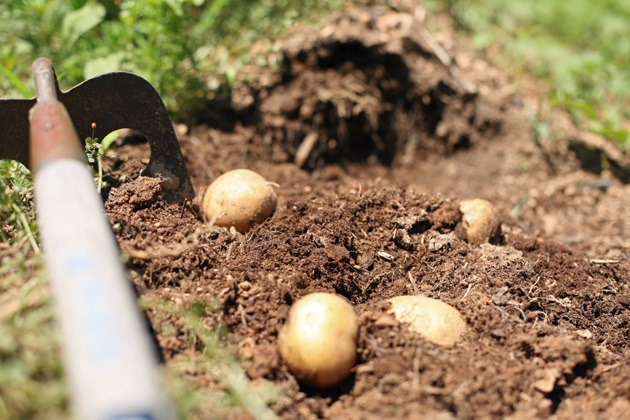
Soil Requirements for Growing Potatoes…
Like most garden vegetables, potatoes love loose soil that is rich in organic matter with a pH of about 6.2-6.8. They are not necessarily heavy feeders like tomatoes, however, you can never add too much compost to your soil (I add animal manure). You can also mix some worm castings in the soil before planting.
Making sure that your soil is loose is very important since it allows beautiful tubers to form. It’s also very important to make sure that your soil drains well. If the soil stays too wet around the potatoes and the plant for too long they will simply rot.
How to Plant Potatoes…
Step 1 – Prepare Your Potatoes For Planting…
When your potatoes arrive, place them in one layer on a counter or in a box or on a tray. It’s important that they have good airflow around them. If you can’t plant right away, you can keep seed potatoes at room temperature for a month or two. If you have to store them for a longer period, they have to be stored at 40 degrees F.
If your seed potatoes already have sprouts, try not to break the sprouts (although it’s not a big deal since they will regrow). If the potatoes don’t have sprouts yet you can presprout them before planting. This is also called greening potatoes and even though it’s a nice thing to do, it’s not a must. You can plant potatoes even before they sprouted and they’ll just sprout in the ground.
If you want to sprout your potatoes, place them (again, in a box or on a counter in one layer) at room temperature in a room that has medium intensity light. Usually, seed potatoes sprout very fast. Within a week or so, you should start seeing sprouts on your potatoes.
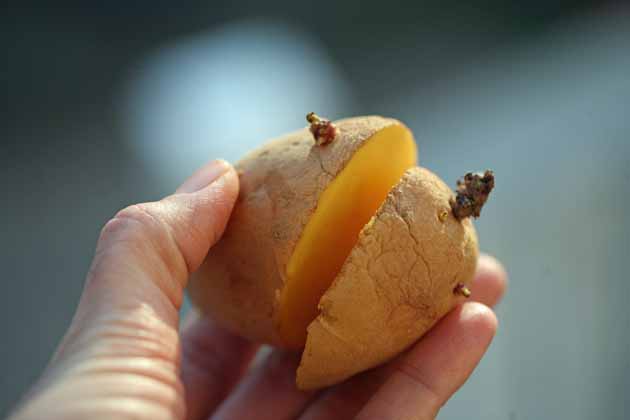
Step 2 – Dividing Seed Potatoes Before Planting…
Potatoes that are the size of an egg or smaller can be planted whole, larger potatoes can be divided into two or three and therefore make more than one plant.
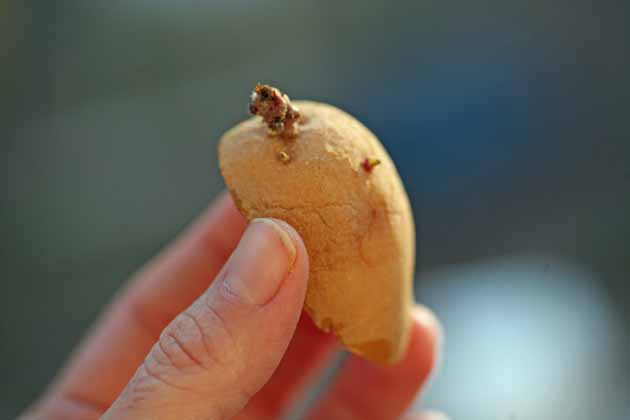
Use a sharp knife with a smooth edge and cut your potatoes in a way that first, the pieces are not too small, and second, that each of the pieces has at least one sprout (or one potato “eye”).
Some gardeners do this right before planting (I’ve done it many times right before planting), but some gardeners will say that after doing this you have to leave your potatoes at room temperature for a few days to scab, or in other words, let the cut dry out. Once it’s dry and “close” there is less of a possibility for the potato to rot in the ground when you plant it.
Step 3 – Planting Potatoes…
Whatever method you choose for growing potatoes, make sure to plant the potatoes 6”-8” deep with the sprouts pointing upward. Space plants 10’’ – 12” from each other and if you plant in rows, for best results, space rows 30”-36” from each other. Make sure that you have plenty of soil around so you can hill it over the plants as they grow.
How to Care For Potato Plants…
Watering – just like most garden vegetables, potatoes need about an inch of water a week. They are a great crop to irrigate with drip irrigation because the drip tape has a drip hole every 12’’ and potatoes need to be planted every 12 inch.
We mentioned this before, make sure that the soil around the plants doesn’t stay too wet for too long. I usually love using straw mulch, however with potatoes we have to be careful with mulch since it keeps the soil moist.
Hilling potatoes – after planting, it will take a week or two for the plants to come up. When the plants are about 8’’ tall, pull some soil around them to cover about half of the plant. Let the plants grow another three weeks and then do this again. Then, let the plant grow the rest of the way until harvest. The extra soil provides more room for tubers to grow.
Fertilizing – potatoes are not heavy feeders. If your soil was amended with compost before planting it’s probably enough for the plants. However, it’s always a great idea to add some organic plant food when the plants are young. I usually use Espoma organic fertilizer, worm castings, or fish emulsion. Hilling time is a good time to fertilize. First fertilize, then hill.

Pest control – There are a few different pests that can harm potatoes but I feel like the one we should talk about most is the Colorado potato beetle. This beautiful beetle feeds on the leaves and multiplies so fast.
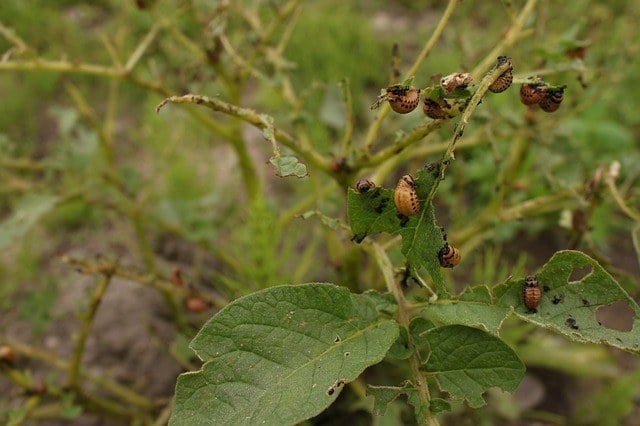
You will find the little brown eggs on the bottom of the leaves, then the brown young beetles that will turn to an adult brown beetle with yellow stripes.
Organically, it’s very hard to control this beetle. You can try diatomaceous earth, you can try neem oil, and you can try to pick them by hand. It’s possible to keep them under control if you are really on it, however, I was never successful in controlling them well or eliminating them or preventing them all together. At least not here in the South (I think that it’s easier to grow potatoes in Northern climates because the beetle is less active there).
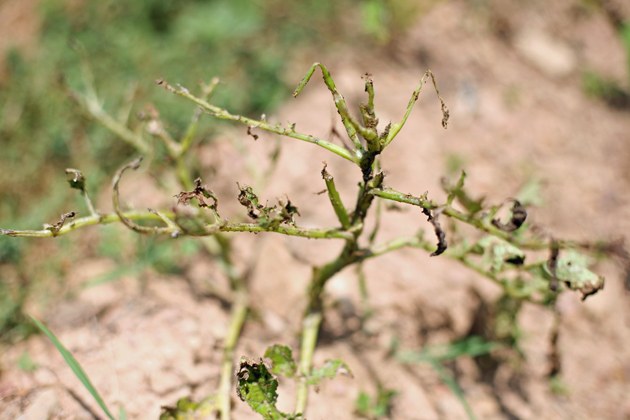
If you spot the Colorado potato beetle on your plants do everything that you can do but also make peace with the fact that they are just a part of the garden. Even if they consume part of the plant, it will probably still produce potatoes. Maybe not as many as if it was completely healthy but a worthy harvest non the less.
There are a few more pests that can bother the potato plant, however they are not as common. To learn more about them, visit this presentation from Oregon State University.
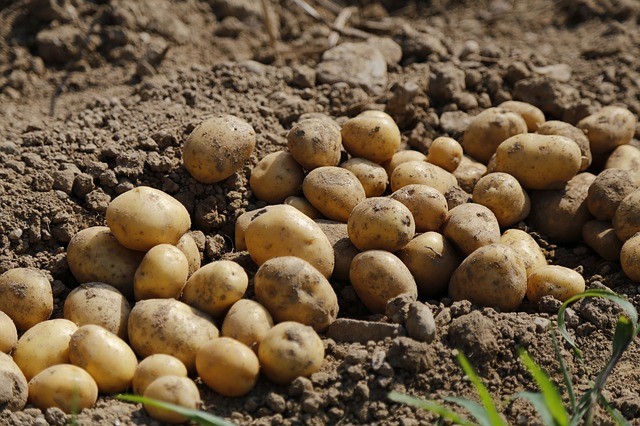
How to Harvest Potatoes…
At some point, depending on the variety of potatoes that you are growing, your plants will start to bloom. Once they are blooming you can ‘rob’ the plants of new potatoes. Just dig gently at the edge of your hill and pick a few potatoes without disturbing the rest of the plant. You can use these potatoes for dinner.
To harvest the main crop, wait until the vines are dead. They’ll simply start to yellow, wilt, and die. Make sure to harvest your potatoes after a few dry days (remember not to irrigate for a few days before harvest). It’s best to simply use your hands to dig potatoes out of the soil, this way there is less chance of damaging them.
You can use a garden fork to loosen the soil but be careful not to stick it right through the potatoes and damage your crop. Consider that most of the potatoes will be right around where the stem of the plant meets the ground, so position your garden fork 20-30 inch or so away from the base of the plant before you stick it in the soil.
DO NOT wash your potatoes after harvesting them! Just brush the soil gently and move on to the next step which is curing your potatoes. If you did damage any potatoes during harvesting, set those aside to use immediately (they will not store well).
How to Cure Potatoes…
Now that all the potatoes are harvested the next very important step is to cure them. Curing potatoes simply means letting them dry and giving the skin time to thicken which will help the potatoes store better.
To cure potatoes, you want to find an area around the homestead that checks most of these requirements…
- A covered area (don’t make the mistake of leaving the potatoes to cure in the garden. At some point it will rain or there might be a wet night and the moisture will ruin your crop).
- A well-ventilated area. Consider adding a fan to move the air around the potatoes.
- An area with temperatures around 50-60 degrees Fahrenheit or so.
- An area with about 80% humidity (don’t sweat this too much).
- And an area that you can leave the potatoes undisturbed for 10-14 days.
- If you can find a dark area, that’s better.
Lay your potatoes on a table or a screen (if you have one) in one layer with a bit of space between them and let them be. Every couple of days, come by and turn the potatoes
How to Store Potatoes…
After curing, it’s time to pack up and store your potato harvest. To Allow airflow, use burlap bags, some kind of net, or baskets to store potatoes. Store your potatoes at 40 degrees Fahrenheit or so. If you have a root cellar, that’s best, if not an unheated garage or insulated shed (where temperatures don’t go below freezing) is good too. It’s also important that the room is dark.
If stored right, potatoes will last 6-8 months in storage. After that they’ll start to soften and will probably root. They are still good to eat even then, but they might not be better for mashed potatoes than fries.
Once a month or so, go over your potato crop to make sure that none of the potatoes are starting to rot. If you find one that is damaged or starting to rot remove it from the rest of the potatoes.
Another way to store potatoes is by freezing them. I love blanching and freezing some of my potatoes as french fries. Then, all I need to do later is pull a bag out of the freezer, spread the potatoes on a baking sheet and stick it in the oven to make homemade fries.
How to Use Fresh Potatoes…
I don’t really need to tell you how to use potatoes, right? The possibilities are endless!
What I do want to tell you is that it’s better to take your potatoes out of storage a couple of days before you plan to use them and set them at room temperature. This will help them build back up some of their starches and they’ll taste even better.
Potatoes are a great crop for the homesteader. They are not too spoiled, they don’t need a trellis or a special structure, they aren’t heavy feeders, and they can be grown in many parts of the country during the winter or very early in the spring.
Of course, they are also delicious, filling, healthy, and store very well. The only hard part are the Colorado potato beetles but a good harvest of potatoes is totally worth the effort.
I hope that this post gave you a better idea of how to grow potatoes, harvest them, and store them. They are definitely a crop worth your time!
More Gardening Content on the Blog…
If you liked this gardening post, also check out how to grow amazing carrots every time and how to grow daikon radish. Check out how to grow asparagus and how to grow beets. Growing purple sweet potatoes is also one of my favorite things to do, as well as growing garlic. And if you’d like to grow some fruit, make sure to check how to plant strawberries (another fun spring crop) and how to plant fruit trees.

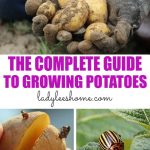
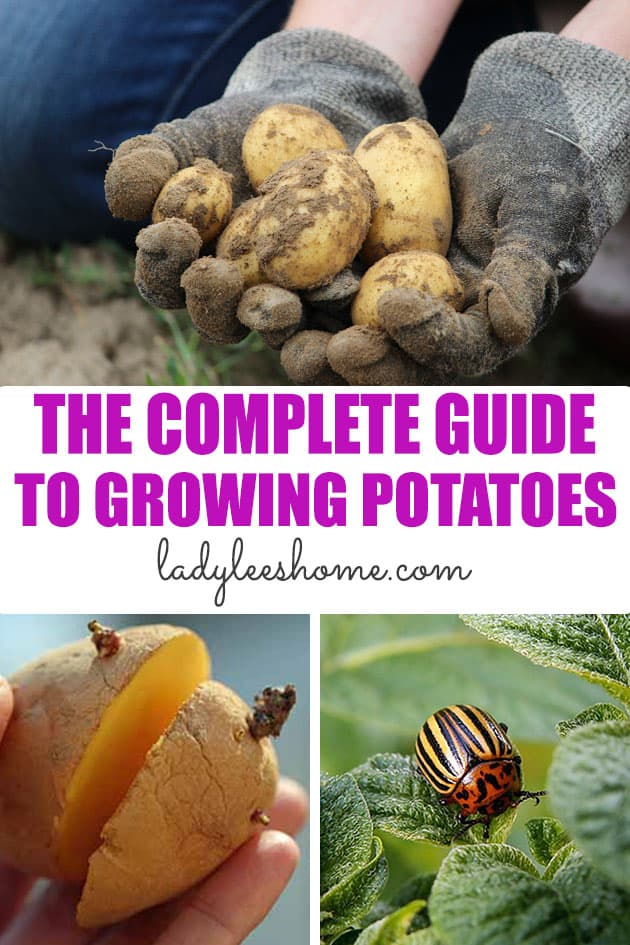
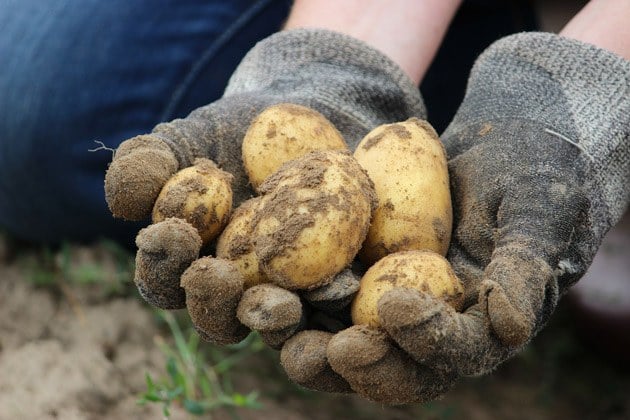
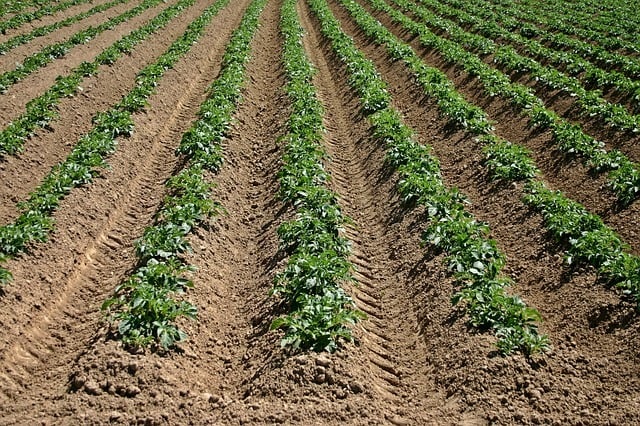

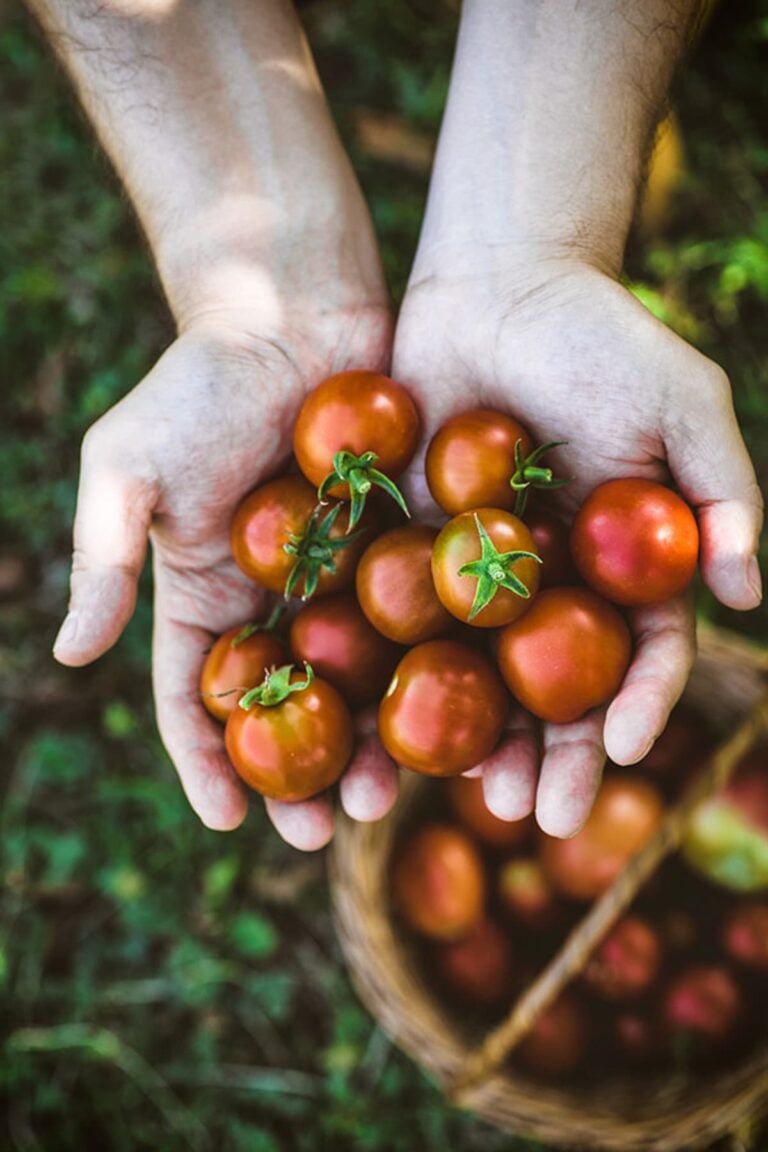
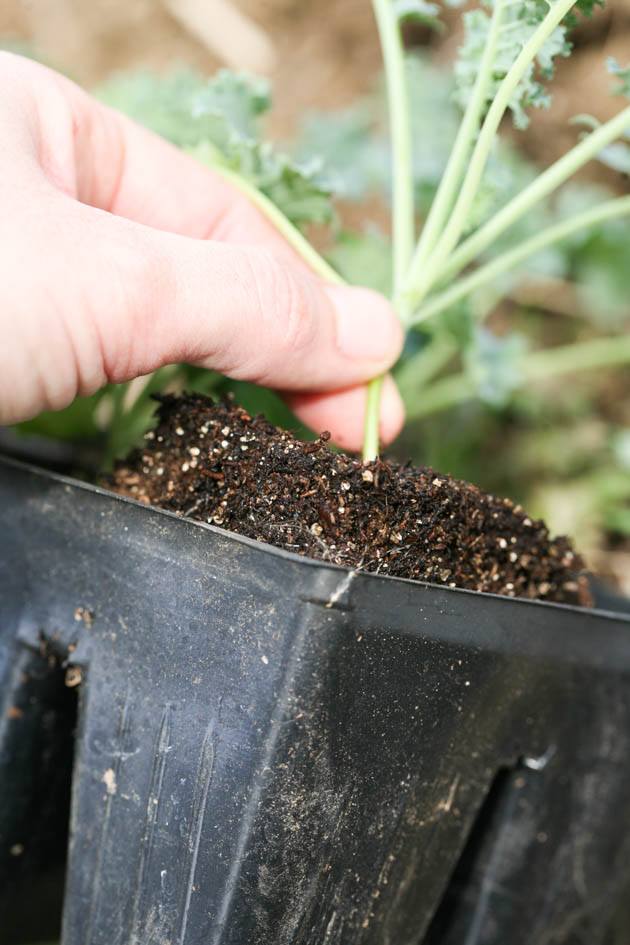
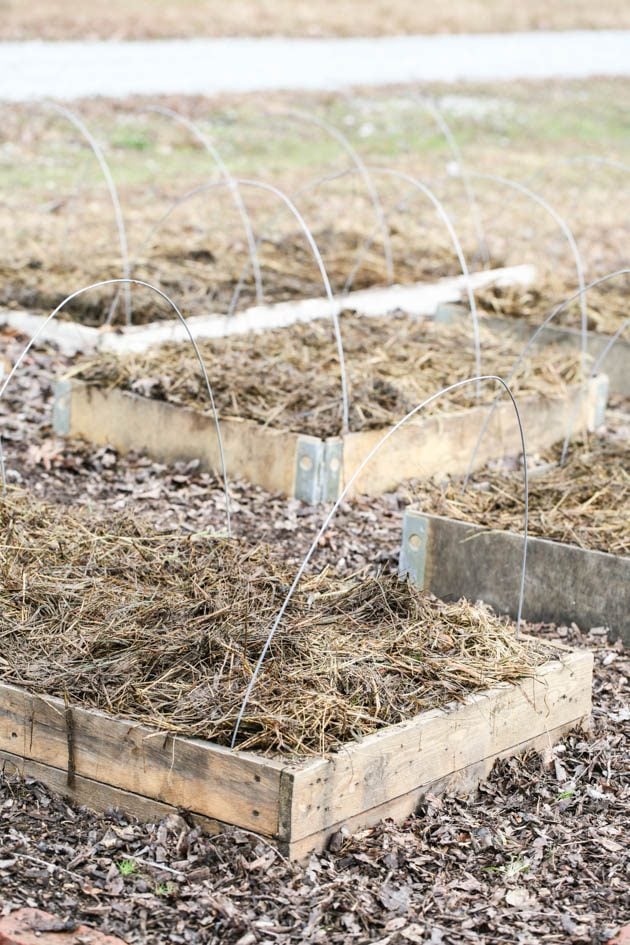
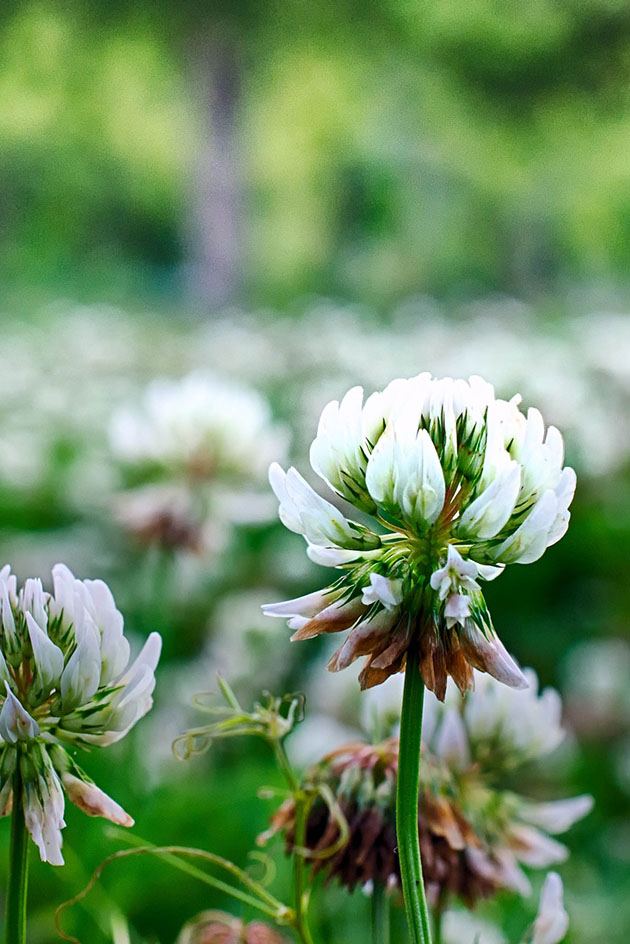
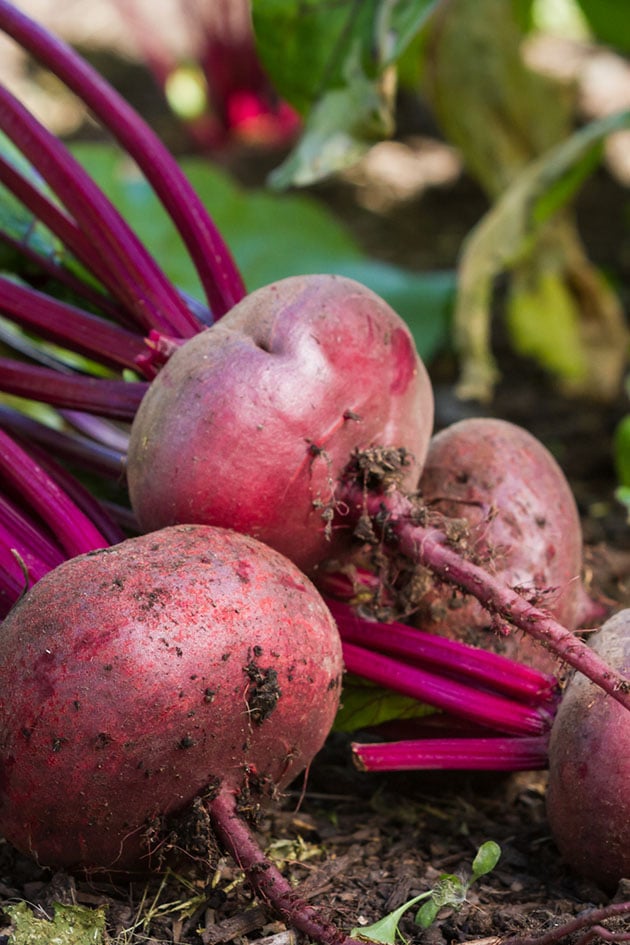
It very interesting info.keep it up
Happy it was helpful! Thanks for stopping by!
thanks alot very good information
You are welcome! Glad it was helpful.
I tried planting potatoes in potatoe bags but they all were so small just couldn’t eat then and I did like you said by adding more soil . How can I get bigger potatoes thank you for posting. Have a merry Christmas and a happy New Year
Potatoes are heavy eaters so you have to make sure they have plenty of compost and fertilizer. Also, make sure they are in full sun and that you use potting soil since you plan in bags.
If you have chickens let them free range for a day in the potato patch. They will take care of your beetle insect problems and you wont have to use any chemicals.
You know, I was thinking about doing that but I wasn’t sure if the chickens will eat the green leaves of the potato plant. I know they like green stuff and that a lot of homesteaders have their garden fenced if the chickens are free around the homestead. I have six chickens, I’ll have to try this this season if I notice the bugs again.
Your right the chickens do like greens. I would only try it for a few hours to let them get to the bugs. The bugs will be a treat to them , However I just read that potato tops are not good for chickens. so I would not let them in the garden very often. Most animals instinctively know what plants they shouldn’t eat
I wonder if guinea hens will be better for this job. I know they eat ticks and other bags but I need to research about them more. I plan to get a few when we move to our 20 acres. There are a lot of ticks here in NC during the summer.
No, please no guinea hens! I don’t know if you tried them but they are dumb as a box of rocks and scratch up and eat everything! lol
Really? I didn’t try them yet but they say that they will eat the bugs but not the plants in the garden this is the only reason I wanted to try them. I don’t need the eggs or meat…
Did I mention they will scratch the heck out of your garden plants also. Glad you didn’t get them. Chickens are the way to go. :))
The Health Ranger said to use Neem as a pesticide. You can get that in the garden store.
Thanks! I will try using it this year.
I am very curious. Did you say you did not have to buy seed potatoes this year? How do you save seed potatoes? Thank you.
So last year most of my potato crop was ruined because of the beetles, but I could still harvest some potatoes. We ate most of them but I saved about 20 for this year. The potato with the sprouts in the picture (where I show how to divide seed potatoes) is one of those I saved from last year.
You supposed to keep them in dark and humid place at 40F. I couldn’t find such a place here so I wrapped the bag of potatoes and stored it in the bottom drawer of my refrigerator.
I am not sure this is going to work (this is why I didn’t share it in the post), but I plan to take the potatoes out of the fridge a few days before planting, divide and plant. We’ll see what happens. I’ll keep you posted.
I would have thought they would have completely shriveled by now in your fridge. PLEASE keep us updated on how they grow, harvest #s, etc. I have NEVER been able to keep my potatoes fresh – they always rot in the basement before we use them all 🙁 but the sweet potatoes do wonderfully. Maybe it’s not cold enough. I’ll have to get a thermometer to check. So you stored ALL of the potatoes you harvested in the fridge? Did you think they tasted different from those stored in the pantry or those from the store?
No, at the beginning, after I harvested the potatoes, I kept them in the pantry. We ate all the bigger ones and I decided to keep the smaller potatoes as seed potatoes. After another month or so they started sprouting. It was way too soon and I wasn’t sure what to do. You are right, here in NC it is simply too warm for potatoes. So I was thinking I’ll try to keep them in the refrigerator and see what happens. I wrapped them and they are in the refrigerator for a few months now. The sprouts didn’t change, didn’t grow any more but didn’t die either, and the potatoes themselves look good. My plan is to take them out and leave them at room temperature for a few days before I plant. I am not sure if this is going to work, this is why I didn’t share it in the post. I’ll keep you updated.
Thank you so much. Sue
You are welcome! Thanks for visiting.